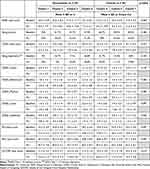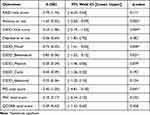Back to Journals » Clinical Interventions in Aging » Volume 18
Inappropriate Analysis of a Cluster Randomized Controlled Trial Due to Not Accounting for Nesting and Clustering [Response to Letter]
Authors Cheung DSK , Lee PH , Lai CKY
Received 4 January 2023
Accepted for publication 19 January 2023
Published 18 February 2023 Volume 2023:18 Pages 231—233
Daphne Sze Ki Cheung,1 Paul Hong Lee,2 Claudia Kam Yuk Lai1
1School of Nursing, The Hong Kong Polytechnic University, Hong Kong; 2Southampton Clinical Trials Unit, University of Southampton, Southampton, UK
Correspondence: Daphne Sze Ki Cheung, Email [email protected]
View the original paper by Dr Cheung and colleagues
This is in response to the Letter to the Editor
Dear editor
We appreciate the interest of the readers regarding the analysis of our study entitled “A home-based dyadic music-with-movement intervention for people with dementia and caregivers: a hybrid type 2 cluster-randomized effectiveness-implementation design”.1 We are writing to respond to the criticism of the validity of the conclusion of our paper. Here, we report the results of the additional analysis to address the potential clustering effects of the intervention on the outcomes as suggested by Hefner et al.2
Our initial published analysis has taken reference to similar studies and relevant guidelines. The objective of our study was to explore the population-average effect (i.e., the impact of the intervention on the participants). Thus, using the generalized estimating equation (GEE) was an appropriate analysis for outcomes variables across the two time points (baseline and follow-up), regardless of the normality of distribution.3 Before conducting the GEE, we confirmed no cluster effect on the major primary outcomes at baseline by using the GLM univariate analysis. The primary outcomes of interest are the anxiety and depressive symptoms of people with dementia, and the perceived stress of caregivers, which showed no significant variation among centres (see Table 1). Hence, we performed the GEE analysis without considering centre as an independent variable. Various teams of authors adopted a similar analytical approach too.4,5
 |
Table 1 Comparing Outcomes at Baseline across Centres |
However, we notice that a sub-scale outcome (Cornell Scale for Depression in Dementia – Ideational subscale) and a secondary outcome (Quality of the Caregiver–Care Recipient Relationship) are significantly different across centres, using an uncorrected p-value cut-off of 0.05, when we revisit the data. Therefore, after discussing with statisticians, we performed a sensitivity analysis by adjusting centres. Similar to the initial published analysis results,1 the GEE analysis adjusted to affiliated centre results showed that participants with dementia in the intervention group had improvement in anxiety status and depressive symptoms; and caregivers in the intervention group also had lowered level of perceived stress as compared to the control group (Table 2).
 |
Table 2 Group x Time GEE Analysis Results Adjusted the Clustering Effects |
Concerning the data sharing request, we have indicated in the Data Sharing Statement section that the datasets are not publicly available due to ethical restrictions. The journal’s data-sharing policy allows the authors to share or not to share the data consistent with the terms of consent signed by study participants. We did not obtain consent from our participants to share the data beyond the research team, so unfortunately, Ms Hefner’s request of the datasets could not be fulfilled. Although we were not asked to provide details about our methods in the email by Ms Hefner in October 2022, as stated in the published Letter to Editor, we trust that this response letter has addressed their query.
There are different ways of handling statistics as long as they are justifiable and help researchers to understand the data, that is why we had never received similar doubts from the reviewers or journal editors. As the late George Box (1976), a British statistician regarded by many as one of the great statistical minds of the 20th century, mentioned, “All models are wrong, but some are useful”.6 We are thankful to the journal for letting us publish the additional data analysis results to clarify the concern being raised.
Funding
The primary study was funded by Ho Cheung Shuk Yuen Charitable Foundation and this additional analysis received no funding support.
Disclosure
The authors report no conflicts of interest in this communication.
References
1. Cheung DSK, Ho LYW, Chan LCK, Kwok RKH, Lai CKY. A home-based dyadic music-with-movement intervention for people with dementia and caregivers: a hybrid type 2 cluster-randomized effectiveness-implementation design. Clin Interv Aging. 2022;11(17):1199–1216. doi:10.2147/CIA.S370661
2. Hefner M, Jamshidi-Naeini Y, Vorland C, Golzarri-Arroyo L, Shaw B, Allison D. Inappropriate analysis of a cluster randomized controlled trial due to not accounting for nesting and clustering: comment on “A home-based dyadic music-with-movement intervention for people with dementia and caregivers: a hybrid type 2 cluster randomized effectiveness-implementation design”. Clin Interv Aging. 2022;2022:1.
3. Diggle PJ, Heagerty P, Liang KY, Zeger SL. Analysis of Longitudinal Data.
4. Lin YC, Wang CJ, Chang YF, Wang JJ. Effects of the biopsychosocial functional activity program on cognitive function for community older adults with mild cognitive impairment: a cluster‐randomized controlled trial. Nurs Health Sci. 2020;22(4):1065–1075. doi:10.1111/nhs.12772
5. Chen SM, Lin HS, Atherton JJ, MacIsaac RJ, Wu CJ. Effect of a mindfulness programme for long‐term care residents with type 2 diabetes: a cluster randomised controlled trial measuring outcomes of glycaemic control, relocation stress and depression. Int J Older People Nurs. 2020;15(3):e12312. doi:10.1111/opn.12312
6. Box GE. Science and statistics. J Am Stat Assoc. 1976;71(356):791–799. doi:10.1080/01621459.1976.10480949
 © 2023 The Author(s). This work is published and licensed by Dove Medical Press Limited. The
full terms of this license are available at https://www.dovepress.com/terms.php
and incorporate the Creative Commons Attribution
- Non Commercial (unported, v3.0) License.
By accessing the work you hereby accept the Terms. Non-commercial uses of the work are permitted
without any further permission from Dove Medical Press Limited, provided the work is properly
attributed. For permission for commercial use of this work, please see paragraphs 4.2 and 5 of our Terms.
© 2023 The Author(s). This work is published and licensed by Dove Medical Press Limited. The
full terms of this license are available at https://www.dovepress.com/terms.php
and incorporate the Creative Commons Attribution
- Non Commercial (unported, v3.0) License.
By accessing the work you hereby accept the Terms. Non-commercial uses of the work are permitted
without any further permission from Dove Medical Press Limited, provided the work is properly
attributed. For permission for commercial use of this work, please see paragraphs 4.2 and 5 of our Terms.
